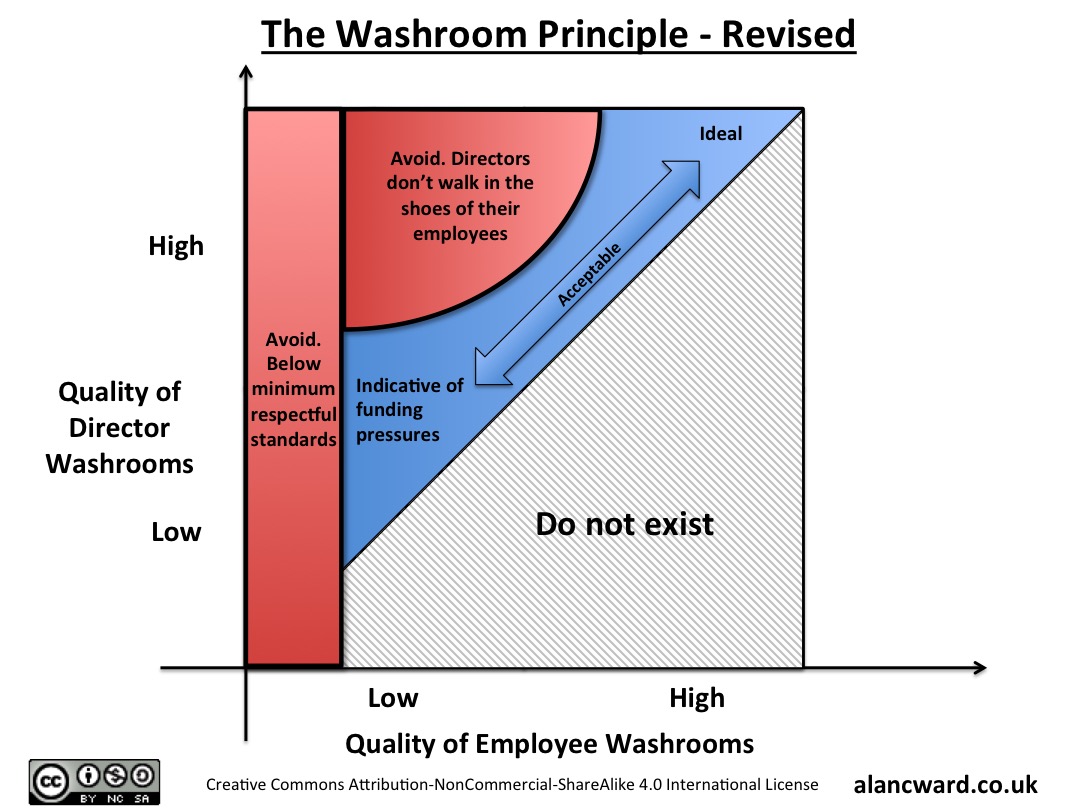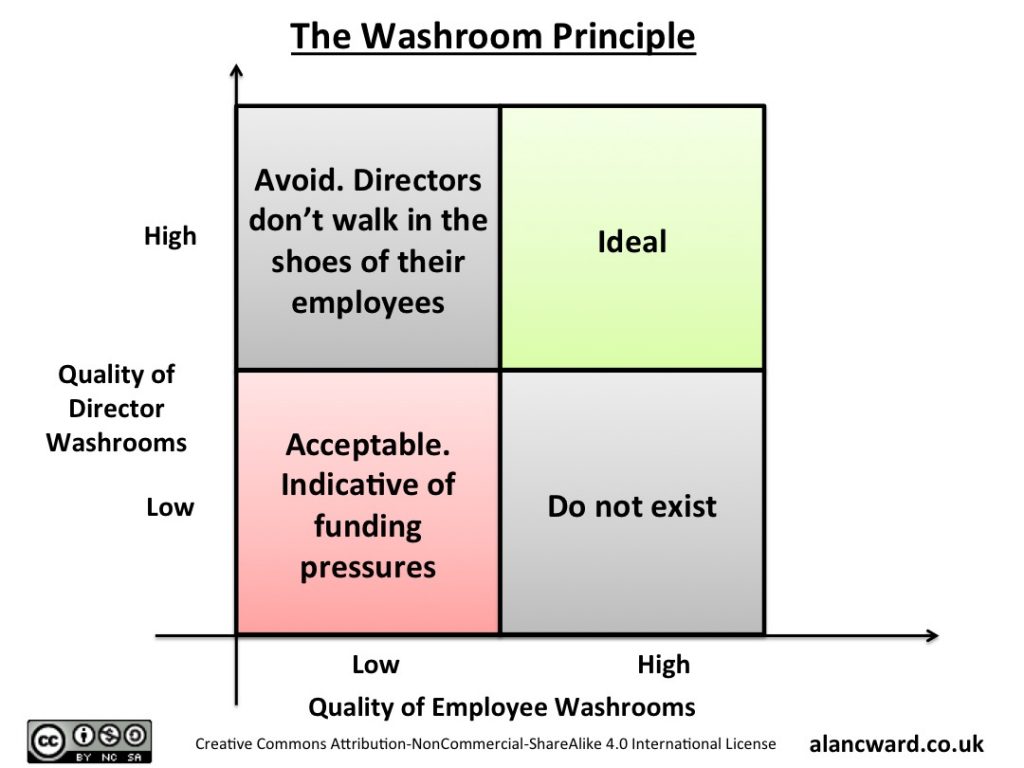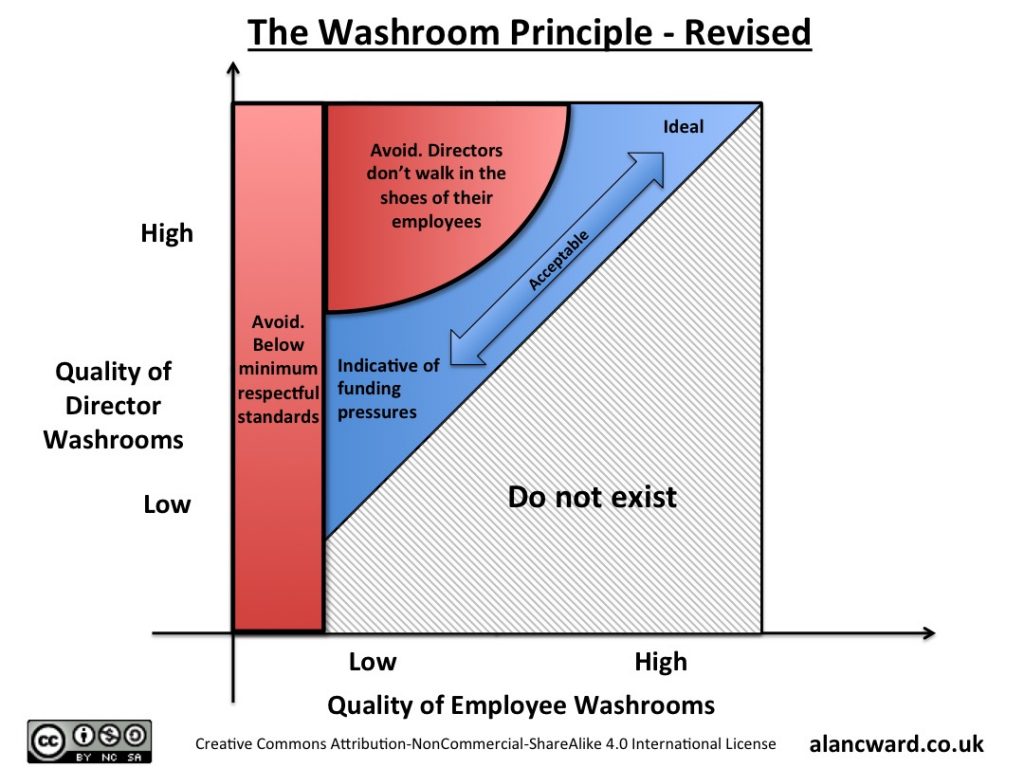The Washroom Principle – The Easiest Way to Evaluate a Company

There are plenty of methods for conducting due diligence, whether for partners, customers, suppliers or mergers. They’re lengthy and they’re expensive. There are times for adopting principles of formal Business Architecture, such as capability matching in M&A situations. But no matter what the deliverables indicate, there’s a useful and quick check to perform as a balance.
I’d like to introduce the quickest method for evaluating a company.
- Check the state of the washrooms nearest the directors
- Check the state of the washrooms in the middle of the office, e.g. where developers work, where finance work, etc
- Compare the two and evaluate according to the 4 box model below
The Simplified View
The simple view consists of a 4-box model with two axis; vertical for the quality of the director/board/exec washrooms and horizontal for the quality of the employee washrooms. That leaves us with 4 quadrants to review:
High quality for director washrooms, high quality for employee washrooms. This the ideal situation. Comfortable for all to work in, with employees respecting their organisation space.
High quality for director washrooms, low quality for employee washrooms. This is a poor situation. It implies one of a few cultural attributes. Either:
- the directors think that they are worth more and merit more than the workforce,
- the directors do not work closely enough with the workforce (and so do not see the disparity) and/or
- the employees don’t care about the quality of the environment (probably resulting from not feeling respected)
Those fall into 2 different categories. The first two fall into whether there is a disparity in provision. The third falls into maintenance and behaviour in an environment.
Low quality for director washrooms, high quality for employee washrooms. I’ve never seen this exist. In all the organisations I’ve work for or consulted for, directors have washrooms of at least equal quality to that of the workforce.
Low quality for director washrooms, low quality for employee washrooms. At least their is parity in these organisations; everyone shares the same facilities. Typically I find these in public sector organisations where money is more importantly spent on providing the services to public rather than on office accommodation.
The More Complex View
The 4-box model gets us to the point of a very quick analysis. But thinking about it further, the relationships are slightly more complex. Hence the revised version:
The revision version uses the same axes as in the 4 box model, but hasn’t been restricted to just the 4 boxes. Instead we’ll take a closer look at the relationships between directors and employee washrooms.
Firstly, the box that related to low quality of director washrooms and high quality of employee washrooms has been extended to a triangle to cover half of the chart. This section, highlighted “Do not exist” relates to any point of the chart where directors have worse quality washrooms than employees.
On the left, we have a basic minimum standard. It’s not an absolute minimum, but one that covers a point at which employees are not being respected.
The top left is similar to that in the 4 box model, again highlighting where directors do not walk in the shoes of the employees.
That then leaves us with a blue area covering an acceptable region. This is the region in which behaviour of the directors matches that of the workforce, with no undue disparity and more a shared “we’re all in this together”. Even with the typical stretched finances of public sector organisations, we should be careful not to stray too far to the left that the lack of care in maintaining washrooms starts to be reflected in the quality of services provided by the workforce.
P.S.
Despite being British (or perhaps because of being British and very British problems), I couldn’t bring myself to call this the “toilet principle”. It was too disparaging and cast the wrong tone for what I intended. Similarly, the lavatory principle didn’t work. The Bathroom Principle sounded good apart from the ambiguity of bathroom=lavatory or bathroom=room with a bath in. I settled on the Washroom Principle as it should be obvious to all (even those in the United Kingdom) which room I mean.




Recent Comments